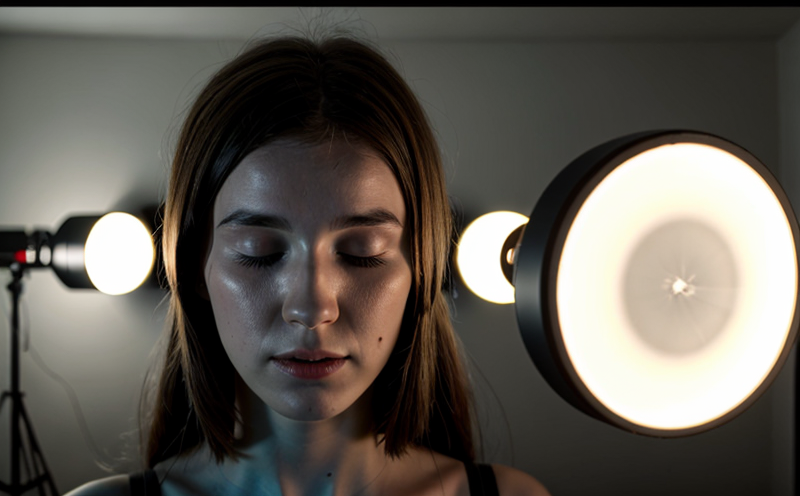ASTM E2837 Flicker Testing of High Brightness LED Devices
The ASTM E2837 standard provides a comprehensive approach to the flicker testing of high brightness light-emitting diode (LED) devices. This test is crucial in ensuring that LEDs do not emit harmful levels of flicker, which can cause visual discomfort or even photic seizures, particularly for individuals sensitive to such stimuli.
Flicker is a phenomenon where the brightness of a light source varies at a frequency that can be perceived by the human eye. For LEDs, flicker can occur due to variations in current or voltage, and it is especially pronounced in high brightness devices used in various applications like consumer electronics, automotive lighting, and architectural lighting.
The ASTM E2837 standard defines flicker as a modulation of light intensity that occurs at frequencies between 1 Hz and 400 Hz. This frequency range is particularly important because it corresponds to the human visual system's ability to perceive changes in brightness. The test measures the modulation index, which quantifies the degree of flicker.
The test procedure involves exposing the LED device to a series of test conditions that simulate real-world usage scenarios. These include ambient light levels, viewing angles, and color temperatures. The device is then analyzed using specialized instrumentation capable of capturing the light intensity variations at multiple frequencies within the 1 Hz to 400 Hz range.
Understanding flicker is critical in the lighting sector because it directly impacts user comfort and safety. For instance, in automotive applications, flickering LEDs can cause driver distraction or even reduce visibility during night driving. In consumer electronics, flicker can lead to visual discomfort, especially for users with photosensitive epilepsy.
The standard provides guidelines on how to prepare the specimen before testing. This includes ensuring that the LED is securely mounted and that it operates under controlled environmental conditions. The test setup typically involves a photometer capable of measuring light intensity variations at specific frequencies.
ASTM E2837 specifies acceptance criteria based on the modulation index. If the modulation index exceeds a certain threshold, the device fails the test. This threshold is determined by considering factors such as the intended use of the LED and the sensitivity of the target audience.
| Modulation Index Thresholds | Intended Use | Sensitivity Target Audience |
|---|---|---|
| <0.3 | General Lighting | Not Photosensitive |
| <0.5 | Automotive Headlights | Photosensitive Epilepsy Patients |
| <1.0 | Consumer Electronics | Variety of Users |
The ASTM E2837 standard is widely recognized and used in the lighting industry to ensure product quality and safety. Compliance with this standard helps manufacturers meet regulatory requirements and gain market acceptance.
Why It Matters
Flicker testing is essential because it ensures that LED devices operate within safe limits, preventing potential health risks and discomfort for users. In the context of consumer electronics, flickering LEDs can cause visual strain, leading to headaches or eye fatigue. For automotive applications, flickering lights can reduce visibility during night driving, increasing the risk of accidents.
The standard is particularly important in ensuring compliance with international safety regulations such as ISO 15926-2 and EN 13034. These regulations stipulate that flicker levels must be controlled to protect the public from potential health hazards.
Flicker testing also plays a role in enhancing user experience by ensuring that LED devices perform consistently across different environments. This consistency is crucial for maintaining brand reputation and customer satisfaction.
Scope and Methodology
- Test Setup: The test setup includes a photometer capable of measuring light intensity variations at specific frequencies.
- Specimen Preparation: Ensure the LED is securely mounted and operates under controlled environmental conditions.
- Data Collection: Capture light intensity variations using specialized instrumentation.
- Analysis: Calculate the modulation index for each frequency tested.
- Acceptance Criteria: Compare the calculated modulation index to specified thresholds based on intended use and target audience sensitivity.
The ASTM E2837 standard provides detailed guidelines for each of these steps, ensuring consistency and accuracy in flicker testing. The scope of the test extends beyond just measuring flicker; it also considers the impact of flicker on user health and safety.
Why Choose This Test
- Ensures Compliance: ASTM E2837 is widely recognized in the lighting industry, ensuring compliance with international standards.
- Protects Users: By controlling flicker levels, this test helps protect users from potential health risks and discomfort.
- Enhances Product Quality: Consistent performance across different environments ensures high-quality products that meet customer expectations.
- Meets Regulatory Requirements: This test is necessary to meet regulatory requirements set by organizations such as ISO and EN.
- Improves Brand Reputation: Ensuring product quality through rigorous testing enhances brand reputation and customer satisfaction.
Selecting ASTM E2837 flicker testing for high brightness LED devices is a strategic decision that benefits both manufacturers and end-users. It ensures that products are safe, reliable, and meet the highest standards of quality.





